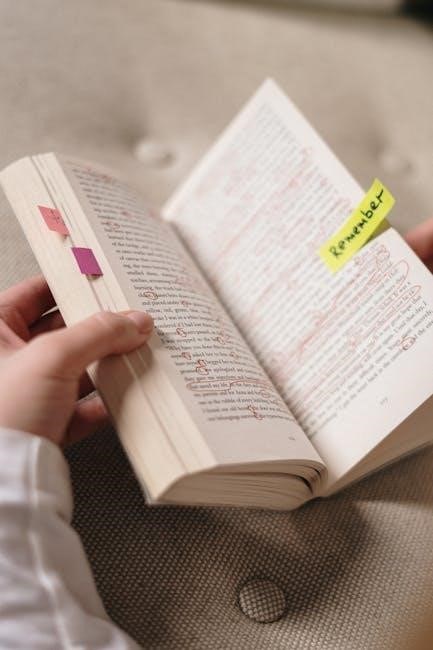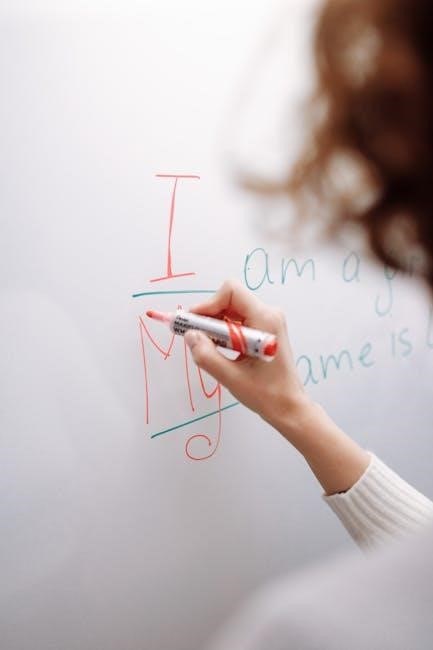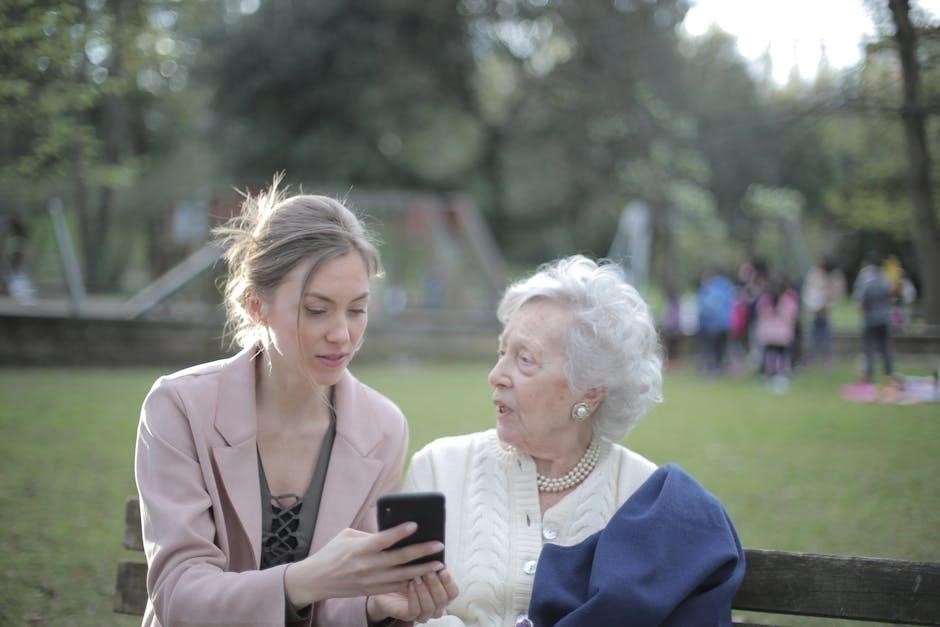Crossword clues are carefully crafted to challenge solvers’ vocabulary, logic, and pattern recognition skills. They require a combination of strategic thinking and linguistic knowledge. Mastering these clues involves understanding wordplay, tense agreement, and part of speech alignment. With practice, solvers can decode even the most complex clues, making puzzle-solving a rewarding mental exercise.
Understanding the Basics of Crossword Puzzles
Crossword puzzles are grid-based word games where words are filled horizontally (across) and vertically (down). Each box in the grid corresponds to a letter, and clues are provided to help solvers determine the correct words. The grid typically features black squares that separate words, and numbers indicate the starting points of each clue. Crossword clues can be straightforward definitions or more complex, involving wordplay like anagrams or puns. Solving crosswords requires understanding clue types, such as definitions, fill-in-the-blanks, and anagrams. Beginners should start with easy clues, like short answers or common phrases. Matching the tense, plurality, and part of speech between clues and answers is essential. Regular practice and using crossword dictionaries can enhance solving skills and enjoyment.
Importance of Clear Clues in Crosswords
Clear clues are the backbone of crossword puzzles, providing solvers with the necessary guidance to fill in the grid accurately. Ambiguity in clues can lead to frustration and confusion, making the puzzle less enjoyable. Well-crafted clues ensure that solvers can progress without guessing aimlessly. They must align in tense, plurality, and part of speech with the answers, avoiding misinterpretation. Additionally, clear clues enhance the learning experience, helping solvers expand their vocabulary and understanding of wordplay. Constructors strive to balance challenge with clarity, ensuring that clues are solvable with logical thinking and knowledge. Without clear clues, crosswords lose their appeal and educational value, making them less engaging for both beginners and experienced solvers alike. Clarity fosters a smoother and more rewarding puzzle-solving experience.

Basic Principles of Crossword Solving
Mastering crosswords requires a strategic approach, starting with easy clues to build momentum. Systematic strategies, like filling known letters, help solvers progress efficiently and confidently.
Matching Tense and Plurality in Clues
One of the fundamental rules in crossword solving is ensuring that the tense and plurality of the clue match the answer. For example, if a clue is in the past tense, the answer must also be in the past tense. Similarly, if a clue is plural, the answer should reflect plurality. This rule helps narrow down potential solutions and avoids confusion. Ignoring this principle can lead to incorrect answers and stalled progress. By paying close attention to these grammatical details, solvers can more accurately deduce the correct words and fill in the grid systematically. This consistency is a cornerstone of successful crossword solving.
Part of Speech Agreement Between Clues and Answers
In crossword puzzles, the part of speech in the clue must align with the part of speech in the answer. For instance, if a clue uses a verb, the answer should also be a verb. Similarly, if a clue refers to a noun, the answer must be a noun. This agreement helps solvers accurately identify the correct word. For example, the clue “Flower” (noun) should be matched with a noun like “ROSE,” not a verb like “BLOOM.” This rule ensures clarity and consistency, making it easier to decode clues. Paying attention to part of speech agreement is a crucial strategy for successful crossword solving, as it significantly narrows down potential answers and aids in completing the grid efficiently.
Abbreviations in Crossword Clues
Abbreviations in crossword clues are essential for solvers to recognize, as they often indicate that the answer is also abbreviated. For example, a clue like “U.S.A.” would correspond to the answer “USA.” Similarly, “Mr.” might clue “MISTER.” These abbreviations are commonly used to fit shorter answers into the grid. Solvers should be familiar with standard abbreviations, such as “Dr.” for “DOCTOR” or “St.” for “SAINT.” Recognizing these patterns speeds up the solving process and avoids confusion. Additionally, some clues may use symbols like “?” to indicate an abbreviation. Paying attention to these details ensures accurate and efficient puzzle completion. Abbreviations are a key part of crossword construction, making them a vital skill for solvers to master;

Effective Strategies for Solving Crosswords
Effective crossword strategies include starting with easy clues, using systematic approaches to fill the grid, and entering known letters to gain momentum and improve solving efficiency.
Starting with Easy Clues
Starting with easy clues is a fundamental strategy in crossword solving. These clues are typically straightforward and require less thought, allowing solvers to fill in answers quickly. By tackling simple clues first, you build momentum and gain confidence. Look for clues with clear definitions or those that ask for common knowledge, such as capitals of countries, famous landmarks, or basic vocabulary; Filling these in first provides a foundation for the rest of the puzzle, revealing letters that can help decipher more challenging clues later. This approach minimizes frustration and sets the stage for a smoother solving experience. It’s a proven method to kickstart your progress and maintain a steady pace throughout the puzzle.
Using Systematic Strategies to Fill in the Grid
Systematic strategies are essential for efficiently filling in a crossword grid. Start by organizing the clues and prioritizing those with unique patterns or fewer letters, as these often yield quicker solutions. Focus on clues that intersect with already-filled answers, using overlapping letters to deduce new words. Elimination techniques can also be useful—ruling out impossible letters or words based on the clues provided. Another effective method is to fill in all the known letters first, even if the clue itself isn’t immediately solvable. This approach helps reveal patterns and connections, making it easier to tackle more challenging clues later. By methodically working through the grid, solvers can maintain progress and reduce guesswork.
Entering Known Letters to Gain Momentum
Entering known letters is a powerful strategy to build momentum in crossword solving. Start by filling in letters you’re certain of, even if the clue itself isn’t fully solved. This approach helps reveal connections between words and can unlock adjacent clues. For example, if you know a common abbreviation or a short word, place it in the grid immediately. This creates a foundation for solving neighboring clues. Look for letters that appear frequently, such as vowels or common consonants, and use them to bridge gaps. By systematically entering known letters, you can expose patterns and relationships, making it easier to deduce unknown answers. This method is especially effective for breaking through stubborn sections of the grid and maintaining progress.

Advanced Solving Techniques
Advanced solvers master techniques like recognizing wordplay, decoding anagrams, and interpreting cryptic clues. These skills require practice and a keen eye for hidden patterns and linguistic tricks.
Recognizing Wordplay in Clues
Wordplay is a cornerstone in crossword clues, often involving puns, double meanings, or clever twists. Recognizing these requires a sharp awareness of language nuances. For instance, clues might use homophones, where words sound alike but differ in meaning, such as “knight” and “night.” Homographs, words spelled the same but with different meanings, like “bank” (financial institution) and “bank” (river side), are also common. Additionally, reversals, where the clue hints at the answer being a word spelled backward, or anagrams, where letters are rearranged, add layers of complexity. Mastering these techniques enhances solving skills and makes crosswords more enjoyable.
Decoding Anagrams and Hidden Clues
Anagrams and hidden clues are popular techniques used in crosswords to add complexity. Anagrams involve rearranging letters to form a new word, often indicated by terms like “rearranged” or “mixed up.” For example, “listen” can become “silent.” Hidden clues, such as containers or charades, require solvers to extract or combine parts of words. Containers involve one word being inside another, like “apple” in “pineapple.” Charades might combine parts of two words, such as “cat” from “candle” and “television.” To master these, solvers should look for such patterns and practice identifying them. Writing down letters and searching for common word patterns can help crack these clever clues effectively. Regular practice enhances this skill, making it easier to spot and decode such wordplay in crosswords.
Utilizing Crossword Solver Tools Effectively
Crossword solver tools are invaluable for tackling challenging puzzles, especially when stuck on a difficult clue. These tools can quickly provide answers or hints, saving time and frustration. To use them effectively, enter the clue and the number of letters you know, and the solver will generate possible answers. They are particularly useful for anagrams or obscure words. However, avoid over-reliance, as solvers should complement, not replace, your problem-solving skills. Regular use can also help identify recurring patterns and themes in crosswords, improving your overall ability to decode clues independently. By balancing tool usage with personal effort, you can enhance your crossword-solving efficiency and enjoyment. Effective use of these tools can transform your puzzle-solving experience, making it both productive and satisfying.

Crossword Puzzle Sizes and Types
Crossword puzzles come in various sizes and types, catering to different skill levels. Mini crosswords (5×5) are ideal for beginners, while standard sizes (15×15) offer greater complexity. Themes and challenge levels vary, ensuring diverse solving experiences.
Mini Crosswords for Beginners
Mini crosswords, typically sized 5×5, are an excellent starting point for newcomers. These puzzles feature simpler clues and shorter answers, making them easier to solve. They introduce basic crossword mechanics, such as word intersections and clue types, without overwhelming the solver. Completing mini crosswords helps build confidence and foundational skills, preparing beginners for larger, more complex puzzles. The smaller grid size allows for faster completion, providing a sense of accomplishment and motivating solvers to progress. Many platforms, like The New York Times, offer daily mini crosswords as a gentle introduction to the world of crossword puzzles. They are an ideal way to hone problem-solving abilities and expand vocabulary in a fun, accessible manner.
Standard Crossword Sizes and Complexity
Standard crosswords typically range in size from 15×15 for daily puzzles to 21×21 for Sunday editions, offering a balanced challenge for solvers. These puzzles feature a mix of straightforward and complex clues, requiring a blend of vocabulary knowledge and logical thinking. The increased grid size allows for longer answers and more intricate wordplay, making them more engaging for experienced solvers. Standard crosswords often include themed puzzles, where answers revolve around a central topic, adding an extra layer of complexity. They strike a perfect balance between fun and challenge, making them a staple for both casual and dedicated crossword enthusiasts. Solving standard crosswords helps refine skills and prepares solvers for more advanced puzzle types.
Cryptic Crosswords and Their Unique Challenges
Cryptic crosswords are renowned for their intricate wordplay and layered clues, presenting a distinct challenge even for experienced solvers. Unlike standard crosswords, cryptic clues combine a definition with a cryptic indicator, such as anagrams, charades, or hidden words. For example, a clue like “Flower in the garden (5)” might lead to “LILIA,” where “LILIA” is hidden within “garden;” Solving these requires identifying the wordplay type and decoding it accurately. The complexity lies in balancing the literal definition with the indirect hint, making cryptic crosswords a true test of linguistic and logical skills. Mastery demands practice and a deep understanding of cryptic conventions, but the satisfaction of cracking these puzzles is unparalleled.

The Role of Themes in Crosswords
Themes in crosswords unify puzzles by connecting clues around a central idea, enhancing engagement and providing context that aids in solving even the most challenging clues.
Understanding Themed Crossword Puzzles
Themed crosswords revolve around a central concept, offering a cohesive experience. These puzzles often feature interconnected clues that highlight a specific topic, such as movies, history, or literature. The theme can be introduced through a title or a series of related answers, providing solvers with a framework to approach the puzzle. Recognizing the theme early on can significantly aid in solving, as it offers contextual clues that link seemingly unrelated answers. For instance, a movie-themed crossword might include character names, film titles, or famous quotes, all tied together by the overarching theme. This structure not only enhances the challenge but also adds an extra layer of enjoyment for solvers who appreciate the thematic coherence.
Using Themes to Solve Difficult Clues
Themed crosswords often provide a hidden framework that can unlock challenging clues. Recognizing the theme early allows solvers to identify connections between seemingly unrelated answers. For example, in a movie-themed crossword, knowing the theme can help deduce a character’s name or a famous quote. Themes also guide solvers when clues are vague or cryptic, offering contextual hints that narrow down possibilities. By leveraging the theme, solvers can fill in gaps where direct clue-solving falters. This approach not only enhances problem-solving skills but also adds an extra layer of enjoyment and logic to the puzzle-solving experience.

Common Mistakes to Avoid
Avoid overreliance on crossword solvers, as it hinders skill development. Ignoring clue patterns and recurring themes can also lead to missed opportunities for solving puzzles effectively.
Overreliance on Crossword Solvers
Overrelying on crossword solvers can hinder your progress as a solver. While these tools are helpful for tough clues, constant use prevents you from developing essential problem-solving skills. Relying too much on solvers means you miss out on the opportunity to learn and understand clue patterns, wordplay, and recurring themes. This dependence can make puzzles feel less rewarding, as the satisfaction of solving a challenging clue comes from personal effort. Instead, use solvers as a last resort after exhausting your own strategies. Trusting your knowledge and instincts is key to improving. Remember, crossword solvers are tools, not substitutes for your own mental flexibility and vocabulary growth.
Ignoring Clue Patterns and Recurring Themes
Ignoring clue patterns and recurring themes can significantly hinder your crossword-solving progress. Crossword puzzles often follow specific conventions, such as repeated wordplay techniques or thematic elements, which provide subtle hints. Overlooking these patterns can make clues appear more complex than they are. For instance, themes often tie multiple clues together, offering indirect guidance. Similarly, recurring clue structures, like anagrams or puns, become easier to recognize with practice. Failing to identify these patterns can lead to frustration and unnecessary difficulty. Paying attention to these elements enhances your ability to decode clues and solve puzzles more efficiently. Recognizing patterns and themes is a cornerstone of mastering crossword puzzles.

Tools and Resources for Crossword Enthusiasts
Crossword solvers, online dictionaries, and specialized software are invaluable tools for tackling puzzles. Essential resources like crossword constructors and themed puzzle guides enhance solving skills and creativity.
Best Crossword Solver Tools Available Online
Several online tools are designed to assist crossword enthusiasts in solving puzzles efficiently. Crossword Solver websites use advanced algorithms to provide answers based on clue input and letter counts. Tools like Word Game Clue Finder and NYT Crossword Solver are popular for their accuracy and speed. Additionally, Armored Penguin Crosswords offers interactive features to help users solve puzzles directly on the site. Crossword Forge is another excellent resource, enabling users to create and solve custom crosswords. These tools are invaluable for both beginners and experienced solvers, helping them overcome challenging clues and improve their problem-solving skills. They make crossword solving more accessible and enjoyable for everyone.
Essential Dictionaries for Crossword Solvers
Educational tools like dictionaries are indispensable for crossword solvers, providing quick access to word meanings, synonyms, and definitions. The Oxford English Dictionary and Merriam-Webster Dictionary are go-to resources for verifying answers and understanding nuanced meanings. Specialized crossword dictionaries, such as the Official Scrabble Players Dictionary, are tailored for word games, listing high-probability words and abbreviations. Additionally, online platforms like WordGameClueFinder and CrosswordForge offer comprehensive databases of crossword answers. These tools are vital for solvers to expand their vocabulary and efficiently tackle challenging clues. They also help identify anagrams and hidden patterns, making them essential for mastering crossword puzzles. Regular use of these resources enhances problem-solving skills and boosts confidence in solving complex crosswords.
Crossword puzzles blend language, logic, and lateral thinking, making them a stimulating mental exercise. Consistent practice enhances problem-solving abilities and expands vocabulary, leading to mastery. Mastering crossword clues brings satisfaction and keeps the mind sharp, encouraging lifelong learning and intellectual growth.
Final Tips for Mastering Crossword Clues
Mastery of crossword clues requires patience and persistence. Start by tackling easier clues to build momentum, then gradually move to more complex ones. Pay close attention to clue patterns, such as tense and plurality, as these often provide critical hints. Wordplay, anagrams, and abbreviations are common in crosswords, so sharpen your ability to recognize these. Utilize crossword solvers as learning tools rather than relying on them for answers. Expand your vocabulary by regularly engaging with crosswords, and embrace the challenge of themed puzzles to enhance your problem-solving skills. Consistent practice will transform you into a skilled crossword solver.
The Importance of Practice in Crossword Solving
Regular practice is essential for improving crossword-solving skills. The more puzzles you attempt, the more familiar you become with clue patterns, recurring themes, and wordplay techniques. Practice sharpens your ability to think critically and make connections between seemingly unrelated words. Over time, it builds confidence and speed, allowing you to tackle even the most challenging crosswords. Consistent practice also enhances vocabulary and strengthens problem-solving abilities. By solving crosswords regularly, you develop a keen sense of language and logic, which are indispensable for mastering this mentally stimulating activity. Embrace practice as a tool to refine your skills and enjoy the rewarding experience of crossword solving.




About the author